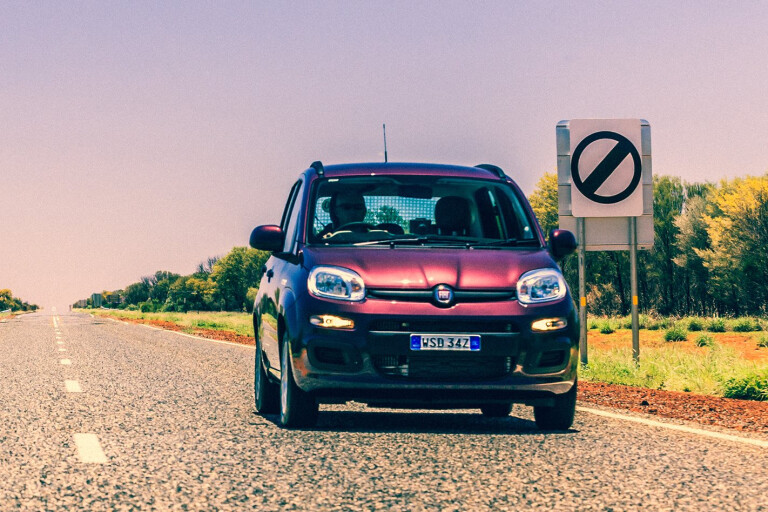
We check out the Northern Territory’s new unrestricted-speed highway for ourselves. Not in a Ferrari, but a baby Fiat.
HUMANS have worshipped some strange things over the millennia – cows, planets, big-nosed statues, pieces of toast that look like a guy with a beard, two bits of wood stuck together to make a Roman torture device, you name it. So it shouldn’t come as a surprise to see people getting a little crazy over a black circle with a line through it, painted on a road sign. Particularly in the desert outside Alice Springs, where the death-ray heat and lung-cloying dust seem to make everyone bonkers.
Every few minutes another car stops and someone leaps out to take a photo of this sign, or even to kiss it. A very excited Japanese tourist snaps pictures with his phone and two different cameras, while his girlfriend sits in their battered Corolla, its Queensland plates telling a story of a journey that might explain why her face looks like she’s just eaten a bag of lemons laced with Valium.
“Did you drive here just for this?” we ask him, from a cautious distance. “Yes! Yes! Ah... No! Yes! Photo! Go! GO!”
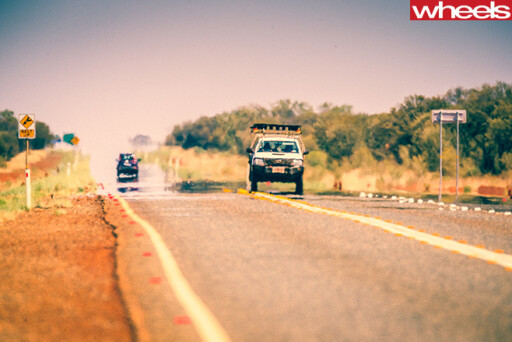 We back away slightly further and watch him disappear into the heat mirage in a ball of dust, only to be replaced by a tattooed local in a Camry, who takes his photo and turns for home. “I just wanted a picture of the sign, but there’s no point even trying it in this shitbox,” he explains, declining to give a name, although I think it was “HATE” judging by his tatts.
We back away slightly further and watch him disappear into the heat mirage in a ball of dust, only to be replaced by a tattooed local in a Camry, who takes his photo and turns for home. “I just wanted a picture of the sign, but there’s no point even trying it in this shitbox,” he explains, declining to give a name, although I think it was “HATE” judging by his tatts.
There’s nothing to explain what the black-on-white sign means, and if you were an uninformed non-German tourist, you’d probably wonder why everyone was stopping here, then heading off at such a speed you might think there was free sex available over the horizon.
You’ve guessed, of course, that it marks the 220km stretch of road on which the Northern Territory government is trialling a resumption of its derestricted highways policy, which was put on ice back in 2006.
We’ve brought a $19,000 purple Fiat Panda with us, of the Twin Air Easy variety, partly because we’re hoping a wedge-tailed eagle will pick it up and fly off with it, but mainly to prove that this utterly unique stretch of road – one on which Speed apparently Does Not Kill – can be safe, even in a tiny city car.
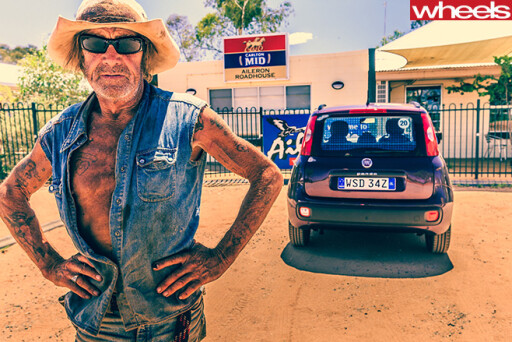 It’s a plan that is greeted with bemused derision by laconic locals before we set off on day one of the trial. Having arrived at lunchtime, we’re asked why we haven’t joined the morning rush of exotic vehicles – a quartet of Porsches, a Ferrari (apparently driven by an ABC journalist; perhaps they do need a budget cut), a Lamborghini, a slew of sports bikes and an Aston Martin driven by a local who later boasts to all and sundry about hitting 270km/h.
It’s a plan that is greeted with bemused derision by laconic locals before we set off on day one of the trial. Having arrived at lunchtime, we’re asked why we haven’t joined the morning rush of exotic vehicles – a quartet of Porsches, a Ferrari (apparently driven by an ABC journalist; perhaps they do need a budget cut), a Lamborghini, a slew of sports bikes and an Aston Martin driven by a local who later boasts to all and sundry about hitting 270km/h.
Perhaps it’s because we’re not very fast, but we don’t catch up to any of these vehicles. They seem to have vanished into the vast expanse of desert, forever. It’s that kind of place. Under its awesome blue skies, with marshmallow puffs of cloud scattered like unwanted mash on a kid’s plate, anything seems possible. Except escaping from the blowflies.
Using what can only be described as Zen-like patience, we wind up the Panda’s awesome 63kW/145Nm 900cc two-cylinder turbo engine and find what feels like its natural, comfortable cruising speed at 150km/h, the tacho pointing up to noon at 4000rpm. This is probably the speed most Pandas sit at on the autostrada in Italy, where it is the country’s best-selling car.
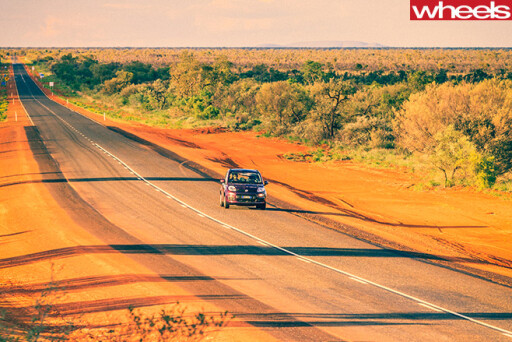 Unlike those racetrack-like roads, where the traffic dices with itself, there are very few other vehicles out here, and 150 feels, well, slow. I know you’ll think I’m just being a rev-head, but it does. The Stuart Highway is so straight, the horizon so far away and objects with which to compare your progress so sparse that it feels like you’re barely moving. The road merely unfolds in front of you, like a big black Gene Simmons tongue.
Unlike those racetrack-like roads, where the traffic dices with itself, there are very few other vehicles out here, and 150 feels, well, slow. I know you’ll think I’m just being a rev-head, but it does. The Stuart Highway is so straight, the horizon so far away and objects with which to compare your progress so sparse that it feels like you’re barely moving. The road merely unfolds in front of you, like a big black Gene Simmons tongue.
Inside the Panda, the deafening coarse-chip-road roar and wind noise would easily drown out any sound of a struggling engine, but it truly doesn’t seem to be working that hard, so we wind it up to 160km/h, then on to an indicated 178 (which turns out to be only 167km/h, according to the TomTom satnav Fiat bolts into these cars).
We sit, foot flat, like this for a good five minutes, and don’t see a living soul. The only thing that happens is that the Fiat appears to get tired, winding back to a satnav-genuine 162km/h, which is as fast as we’ll see over the next two days.
 As the days click over, we pass the inevitable road trains – which feels like a puppy overtaking an elephant – and cover large chunks of kilometres in what seems like good yet unremarkable time. Driving out here, like this, feels easy, safe, even sensible. The only heart-in-mouth moment is when we see a willy willy whipping up red dust in a whirl and heading for us. It hits the road, and shakes the car violently sideways. It’s quite possible the Fiat designers never contemplated willy willys in the design brief, but it’s a reminder of how thin and light (985kg) the Panda is.
As the days click over, we pass the inevitable road trains – which feels like a puppy overtaking an elephant – and cover large chunks of kilometres in what seems like good yet unremarkable time. Driving out here, like this, feels easy, safe, even sensible. The only heart-in-mouth moment is when we see a willy willy whipping up red dust in a whirl and heading for us. It hits the road, and shakes the car violently sideways. It’s quite possible the Fiat designers never contemplated willy willys in the design brief, but it’s a reminder of how thin and light (985kg) the Panda is.
What’s remarkable about the road is that even when there is a bend – and they don’t come often – the authorities haven’t chosen to implement, or even advise, a maximum speed. It’s as if they actually think drivers have minds of their own. Incredible.
There’s no doubt the locals would make challenging constituents. At the Aileron Roadhouse, 160km out of Alice, publican Greg Dick calls a spade something to hit you over the f---in’ head with.
 A prominent sign in his dining room points to the SHITHOUSE. “It’s not a rest room, it’s not a toilet, it’s a shithouse,” he explains, kindly. “I had some woman come in here and say, ‘I find that offensive’, and I said, ‘Well f--- off and shit in the bush then’. Christ, it’s my f---in’ place.”
A prominent sign in his dining room points to the SHITHOUSE. “It’s not a rest room, it’s not a toilet, it’s a shithouse,” he explains, kindly. “I had some woman come in here and say, ‘I find that offensive’, and I said, ‘Well f--- off and shit in the bush then’. Christ, it’s my f---in’ place.”
Dick, 68, has been ‘speeding’ across the Territory’s roads his whole life. “Well, they call it speeding. I call it driving,” he chuckles, croakily. “We all speed up here; we all sit on 180 – that’s my minimum, basically. That’s what all bushies do. If you’re in a hurry you might do 195, 200.
“It’s just normal driving. Shit, yeah. I used to slow up when they made it 130. You’d think, ‘Holy shit, how do people drive this slow?’ As for 110, that's disgusting; yeah, disgusting.”
What about the idea that Speed Kills? “I don’t know,” he says, his shotgun speech taking a rare pause. “Well, it does if you have an accident, I guess; piece of piss. Sitting on 180, you want to keep good tyres all the time; you don’t want a blowout, you’d be f---ed, simple as that.”
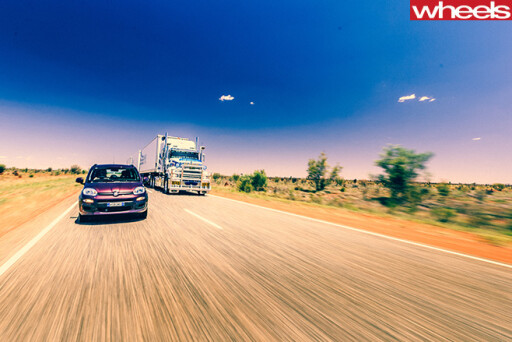 Dick says the locals aren’t that excited about the trial of derestriction, because they all ignored the 130 limit anyway. He claims never to have been booked because the cops simply let off the locals.
Dick says the locals aren’t that excited about the trial of derestriction, because they all ignored the 130 limit anyway. He claims never to have been booked because the cops simply let off the locals.
“I guess the only difference is you’ll be able to enjoy the view without worrying if the car coming towards you is a cop. I think the cops are a bit worried about hoons, or tourists coming out here and having an accident, and then they’ll have to put the limits back. No-one wants that. But the tourists won’t try it; they’re too worried about the price of fuel. Ha!”
Dick admits he doesn’t get great fuel economy out of his Holden Colorado by sitting at 180km/h – averaging between 260 and 300km from a tank – but he reckons it beats driving slowly and dying of boredom.
He’s most pleased about the possibility of car companies returning to the area to do their hot-weather testing because they used to stay at his establishment for three months at a time, and it made him a lot of money.
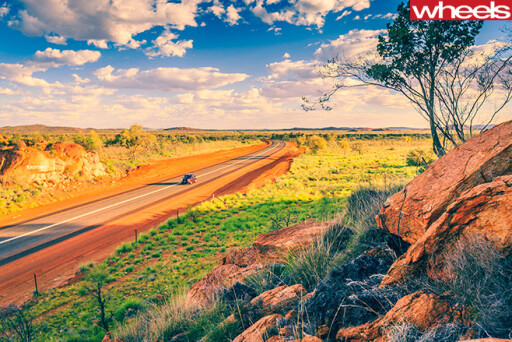 We step outside to check if the Panda has melted in the 42-degree heat yet, and find a group of big-boned locals openly mocking our car for being “ugly” and “girly”.
We step outside to check if the Panda has melted in the 42-degree heat yet, and find a group of big-boned locals openly mocking our car for being “ugly” and “girly”.
“What happens if you hit a roo in that at 180km/h?” a balding, rounding man known only as ‘Curly’ asks. I happily inform him that won’t be possible because it won’t go that fast.
Josh Bereshezckiy, 21, is glad we’re trying to explain that the speeds at which he regularly drives can be safe. “People say it’s crazy and speed’s gonna kill ya, but it doesn’t, not on a road like this,” he says.
“The thing is, 130 was just too slow; you’d fall asleep at those speeds. People need to try it. People who haven’t driven the Stuart Highway think the unrestricted limit is crazy and we’re all going to die, but it’s not. It makes perfect sense and if you’ve driven here your whole life at 180, you know how to do it. It’s easy.”
With fresh warnings about emus, horses, donkeys, camels and cows ringing in our ears, we push on into the unchanging desert, bobbling along at an easy 150km/h, and run into a moral dilemma. We come up behind a highway patrol car going slightly slower than us. It’s not breaking the law to overtake him, and it would certainly be a memorable experience, but it might also be asking for trouble.
 According to NT transport minister Peter Styles, a former copper himself, the police have the discretionary power to book people for driving in a manner dangerous, but he hasn’t put a number on what that is.
According to NT transport minister Peter Styles, a former copper himself, the police have the discretionary power to book people for driving in a manner dangerous, but he hasn’t put a number on what that is.
“The people in the bush asked us to look at bringing these rules back and people in the bush are well aware that it’s not an autobahn; they were just concerned about fatigue issues, about getting to their destination before dusk,” he says.
“There will only be one or two people who want to do 250km/h, and frankly if they haven’t got tyres that are rated for that speed, or it’s not right for the conditions, they’ll find the police will be talking to them.
“The whole thing is about personal responsibility, about people deciding for themselves what is the right speed for their car, for their driving skill, for the conditions.
“A lot of people will tell you at 110 they go to sleep, but at 140 they’re awake; it’s the stimulation of movement that keeps the brain alert. But basically it’s about getting there quicker, and an extra 20 or 30km/h, over a day, when you’re driving Darwin to Alice, makes a big difference.”
Let’s just pause for a moment to reflect on the fact that this is a politician who is saying these things. In retrospect, I’m not sure the NT is in Australia at all.
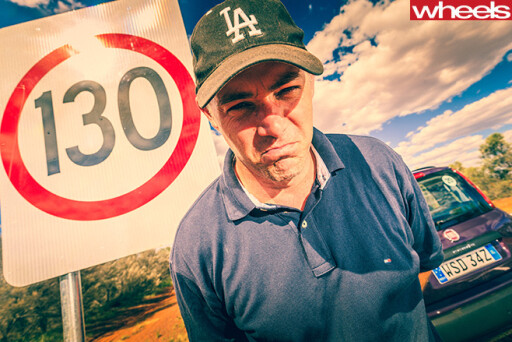 After filling up at Ti Tree (we’d thought the Panda’s 40-litre tank might be a problem, but even travelling at speed it managed a respectable 11.4 litres per 100km) a town inhabited mainly by a few million friendly stink bugs, we hit the end of the road, figuratively, at a seemingly random point in the middle of nowhere, 60km shy of Barrow Creek.
After filling up at Ti Tree (we’d thought the Panda’s 40-litre tank might be a problem, but even travelling at speed it managed a respectable 11.4 litres per 100km) a town inhabited mainly by a few million friendly stink bugs, we hit the end of the road, figuratively, at a seemingly random point in the middle of nowhere, 60km shy of Barrow Creek.
I never thought I’d be unhappy about seeing a 130 speed limit sign, but this one seems absurd and unnecessary. We watch in horror as a police car books a motorist heading towards us, catching him just 500m before the derestricted sign. Can’t have been a local.
Fortunately we can just turn around and head back again. As the sun sets, almost unbearably red as it hits the ochre dust plains around us, I curse Curly loudly as a staggeringly large red roo nearly brings our mission to a messy end. Our support vehicle, a Toyota LandCruiser that’s spent most of the day boiling and slowing us down, is encouraged to take the lead, and we cruise back to Alice at a mere 140km/h.
We’re keen to try again the next day, and head out of town behind a Chrysler 300C SRT8 with NT plates, sitting exactly on the 110 limit. The moment we hit the black circle sign he launches away from us as if we’ve been thrown into reverse. We’re doing 150km/h and he’s vanishing fast, but even so the horizon is so far away we can still see the black dot in the distance for a few minutes.
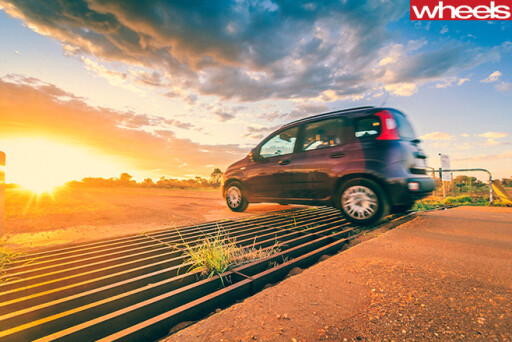 The day before we hadn’t been overtaken once – the NT experience is as different from autobahn driving in Germany as a Chiko Roll is from sauerkraut – but today a Suzuki Hayabusa goes past us like a flash of black light.
The day before we hadn’t been overtaken once – the NT experience is as different from autobahn driving in Germany as a Chiko Roll is from sauerkraut – but today a Suzuki Hayabusa goes past us like a flash of black light.
We eventually find the bike’s owner, a secretive and sweaty chap who says he works at the infamous Pine Gap US base and can’t give us his name, but is happy to report he topped 280km/h. “They reckon the bike can do 300, easy, but I’m too fat to get down behind the screen.”
The locals are clearly enjoying their newfound freedom to the full. And for the first time ever – just for one mad, sun-soaked moment – I think it might not be such a bad place to live.
Seeking a hire state
AS A BIT of an amateur scientist, I felt it fell to me to fully test the hypothesis put to me by so many locals: that 180km/h is the best speed for traversing the Stuart Highway.
The Panda was no use for this, so I decided to also test the well-known theory that hire cars are the fastest vehicles on the planet, enlisting the help of a well-used VE Commodore we had picked up at the airport.
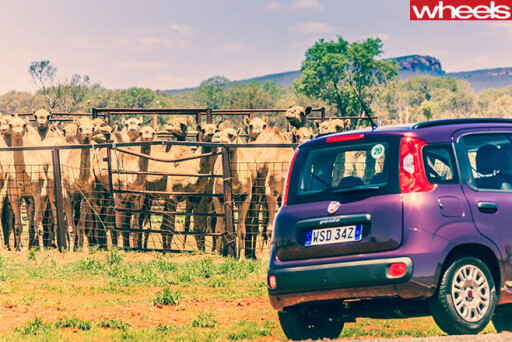 With a ride that felt as smooth as an S-Class Benz after the Fiat, the Holden hurled itself effortlessly up to 180km/h and sat there with ease. Sure enough, even at that speed I didn’t feel the kind of horizon-rush you would expect from that number, but I did feel handily focused on the job at hand. After driving the Commodore for a while, though, I noticed I fell most comfortably to a speed of around 165km/h, a kind of Goldilocks speed, if you will.
With a ride that felt as smooth as an S-Class Benz after the Fiat, the Holden hurled itself effortlessly up to 180km/h and sat there with ease. Sure enough, even at that speed I didn’t feel the kind of horizon-rush you would expect from that number, but I did feel handily focused on the job at hand. After driving the Commodore for a while, though, I noticed I fell most comfortably to a speed of around 165km/h, a kind of Goldilocks speed, if you will.
The slightly second-hand steering of the VE felt almost alarmingly loose at the straight ahead, so you wished you were in a VF instead, but you soon got used to the lack of feel.
My thirst for scientific discover also led me to test out the car’s V-max, which turned out to be an indicated 227km/h. Just because I knew you’d be wondering.
A Bitter twist
VICTORIA Bitter was, for a long time, Australia’s best-selling beer – shifting a carton every two seconds at its peak of popularity.
If you’re wondering where all those cans went, I now have the answer. We stop quite regularly on the side of the road for photography, and on that 220km stretch of the Stuart Highway I didn’t once get out of the car without being able to point to at least half a dozen VB cans within a five-metre radius. Many of them faded almost to oblivion, and some dating back to the pre-aluminium period.
 This might sound like exaggeration, but I promise you it’s not. The green and white cans damn near outnumber the blowflies, which is saying something.
This might sound like exaggeration, but I promise you it’s not. The green and white cans damn near outnumber the blowflies, which is saying something.
Their proliferation along the roadside does suggest a disturbing tendency among the locals to drink, drive and litter, but this was one subject on which our publican friend, Mr Dick – standing in front of a fridge packed with cold VB cans for individual sale – had no comment.
Strange.
Take your medicine
WHILE it might be popular with residents, the trial has been hammered by outraged officialdom. The College of Physicians, the Australian Medical Association, the College of Surgeons and the College for Emergency Medicine have all argued that it is irresponsible and dangerous.
Christine Connors of the College of Physicians says the trial will claim lives and the NT government is ignoring all medical evidence about the impact of speed.
“It is just a disaster that is waiting to happen,” Dr Connors said. “The problem is the disaster is going to be more families of the Territory losing family members.
“If they have decided deliberately to allow open speeds, against all of the evidence and against all of the trends internationally, they would have to take responsibility for deaths.”
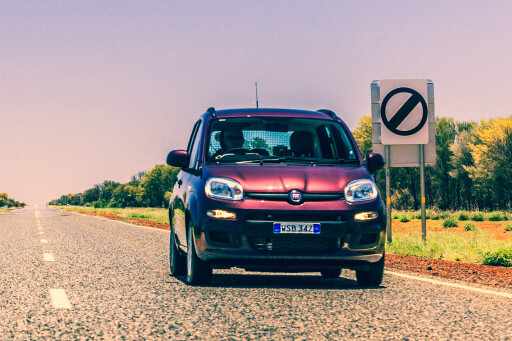 NT transport minister Peter Styles does not accept that unlimited speeds will cause death and mayhem, and the figures support him.
NT transport minister Peter Styles does not accept that unlimited speeds will cause death and mayhem, and the figures support him.
Back when NT roads were derestricted, in 2004, the road toll was 35. It was 55 in 2005 and 44 in 2006. The 130 limit came along in 2007 and the toll hit 57, and the next year it was 75. Last year it was 49, but there has not been a speed-related death on the trial section of road for more than a decade.
“The fact is the majority of our road deaths up here involve pedestrians getting run over, wandering out onto the road at night, or they get hit after sleeping on the road for a bit of warmth – those are mainly Aboriginal people, living on settlements, and it’s very sad,” Mr Styles said.
“Other than that, alcohol and people driving without seatbelts are our biggest killers. We have a lot of multiple deaths – a LandCruiser going over with several people on board unrestrained – and that can throw out our stats enormously as well.”

COMMENTS